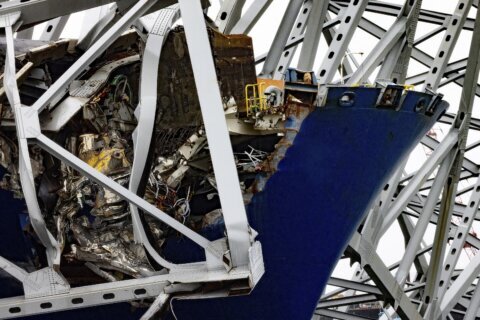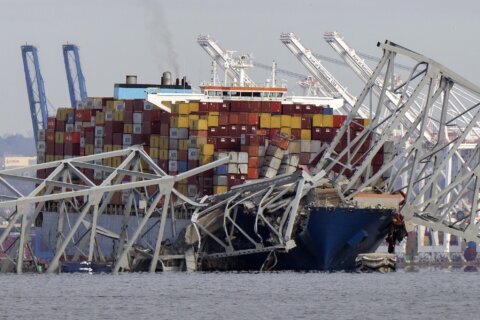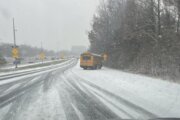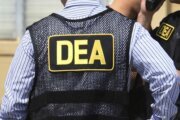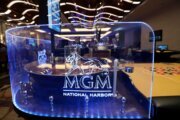Wednesday marks one year since a huge container ship struck and brought down most of Baltimore’s Key Bridge.
The early morning tragedy on March 26, 2024, not only left a gaping hole in one of the busiest shipping channels along the East Coast, but also an emotional hole for the families of the six construction workers who were on the bridge at the time and were killed.
It was a Herculean effort to remove the thousands of tons of twisted steel and concrete over the next 11 weeks and get the full channel reopened.
The removal of the debris also called for a meticulously coordinated effort by many agencies across several months.
At the top of recovery coordination efforts was Maryland Gov. Wes Moore, who joined WTOP’s Shawn Anderson and Anne Kramer on Wednesday to reflect on that day.
Read and listen to the interview below.
The following transcript has been lightly edited for clarity.
Wes Moore: I’ll never forget. My phone rang at 2:02 in the morning, and it was my chief of staff who called me, and the first words out of his mouth was, “Gov., I’m so sorry, but the Key Bridge is gone.”
I immediately just tried to unpack exactly what he just said. And then a little bit later, he sent me a video of the Key Bridge collapsing, and it still didn’t even look real. And then we literally spent the — that next moment putting the state on a state of emergency.
I was on the phone with our state police and our divers, just ordering and understanding as to what was happening, what was going on. We were on the phone with the FBI, because at that point we still weren’t sure — was there terror involved in it?
It was a very chaotic moment. But then, also, I think the most important time for me was when we got a chance to meet with the families — that first morning — and praying with them. And it was just a day I’ll never forget.
Shawn Anderson: Have you spoken with the families directly since then? And, if so, what have they been telling you as we’ve reached this one year mark?
Moore: We’ve stayed in constant communication with the family from the time that we went from search and rescue to our search and recovery mission, to the time when we took them out on the water, the first Father’s Day after the fatal crash, to see the site for the first time, for many of them.
Late last night, I had dinner with the families and the first responders. And, so, the thing that I think they continue to see is that the pain that they feel, it’s still there. It’s still very present. The trauma that they still feel is still very present.
But I wanted them to know, and they will always know, that they have me and they have this entire state, who is going to support them throughout because their family members were simply trying to make our lives better, and they lost their lives in the process.
Anne Kramer: Talking about the tragedy for the lives lost, but also the landscape changed for thousands of people who every day depend on the Key Bridge to get around Baltimore. Wondering if you’re still hearing, one year now removed, from those frustrated drivers?
Moore: I’ve been so grateful at the patience and the resilience that people have because, remember, to get to the Port of Baltimore there’s only three ways to get to the Port of Baltimore, non-maritime. It is the Fort McHenry tunnel, it’s the Harbor Tunnel, and it was the Key Bridge.
Now, you’re watching all these trucks, lot of them heavy load trucks that would have normally taken the Key Bridge to get to the Port of Baltimore, which are now being detoured through neighborhoods, and detoured through communities.
And so, we have — I and the Department of Transportation — have been continuing to work to come up with alternative routes and come up with additional ways for people to move around.
But, the reality is, one of the many reasons that I’ve been so insistent on “we’ve got to get this bridge rebuilt as quickly as possible,” is because the strain that we’re putting on our passengers as they’re moving around and going from where they live to where they work.
It is undoubtedly changed when one of the main arteries is no longer there.
Anderson: Now, the NTSB was highly critical of what the state of Maryland did not do when it came to ensuring the bridge was safe and doing the safety checks before it was hit. How confident can drivers be that Maryland will do all it can in the future to keep using those bridges, like the Bay Bridge for example, safe now and in the future?
Moore: I think it is important to remind people that the Key Bridge, the Bay Bridge, and all the other bridges in the state of Maryland have never failed a federal assessment.
What the NTSB was saying was that the Key Bridge, along with 68 other bridges around the country … that there is an assessment on a weight collaboration that has to be understood.
But, I think that us knowing that, that our bridges, along with those 68 other bridges, fall into that category, that we have not just passed all assessments when it comes to federal standards, but we put over $170 million in the past 10 years alone toward the Bay Bridge.
In fact, I authorized an additional $160 million just last year going toward the Bay Bridge. And, so, keeping our people safe has and will always be my No. 1 priority, and that includes safety on the roadways, safety on bridges, safety in tunnels, etc.
But I know that we will always comply with the NTSB. But what the NTSB released wasn’t necessarily a siren cry about Maryland. It was really a siren cry on Congress and to the federal government about our larger infrastructure challenge that we have inside this country.
Kramer: Speaking of the federal government, how concerned are you that federal funding will not be there to pay for a new Key Bridge, given what’s been happening with the Trump White House and decisions coming from President Trump?
Moore: What I know is that we received bipartisan support for a 100% cost share on the Key Bridge, because we are in this litigation, and even as Lloyd’s of London points out, this is going to be the most expensive maritime tragedy in our nation’s history.
So, the thing that we also do know, very much, is that the Congress has already approved the 100% cost share. So, we fully expect Congress to be able to honor its word. We fully expect Congress to be able to make sure the 100% cost share stays intact. And we’re moving in a pace and in a method of showing that we’re not going to wait for any type of changes.
We’ve already started our process of evaluation of soil sampling. We plan on not just having the full demolition of the remaining pillars of the bridge completed this week, we also plan on the reconstruction of the bridge starting later on this year as well.
So, we’re confident that we want to be able to get this thing done as quickly and as safely as possible. And we are also confident that Washington will honor its promise to us as well.


